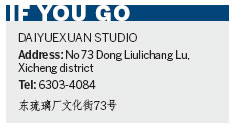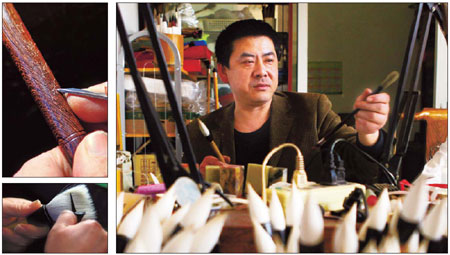Art
Brushing up on ancient tradition
Updated: 2011-04-13 07:56
By Wang Wen (China Daily)
|
Clockwise from right: Wu Jie, a writing brush making master at Daiyuexuan studio, explains that it takes more than 100 steps and at least a week to finish a brush; Arranging the hairs to create a brush tip is meticulous work; Chinese characters are carefully etched on the handle as the final step to completing a brush. Zou Hong / China Daily |
 |
A century-old studio is one of the country's last remaining producers of historical writing tools, Wang Wen discovers.
While a Daiyuexuan studio writing brush may cost only 5 yuan, it undergoes more than 100 steps before it reaches the store's shelves.
The studio is named after its founder, Dai Yuexuan, a native of Huzhou in Zhejiang province, who opened his writing brush shop in Beijing in 1916. He made the brushes by hand, according to the Huzhou style - the country's most famous variety since the Yuan Dynasty (1271-1368).
Huzhou brushes are created through a process known as pizhufa in which myriad layers of hair are wrapped around the handle.
"Machines can't do it as well as people," said Yu Tianying, president of Beijing Daiyuexuan Huzhou Writing Brush and Anhui Ink.
"You need an experienced human hand."
The process requires 10 basic steps comprising 100 procedures that take at least a week to complete.
The most crucial step is called shuipen (water basin). This is when hairs are selected from limewater and sorted according to their properties. Different types of hair are used to form different parts of the brushes.
Workers repeatedly wash and comb the hair before arranging it to create the brush's tip.
Daiyuexuan's writing brushes are generally divided into three categories: goat hair, weasel hair and mixed-hair. Mixed-hair brushes are an innovation of Daiyuexuan. Because goat hair may be too soft on its own, a better brush can be made by mixing it with other materials, such as bristle and horse hair.
The studio is roughly 10 square meters, where in which eight workers hunch over the brushes they are working on. But this team can only make part of the brushes, so other workers in a factory in South China do the rest.
Daiyuexuan's brushes have made their way to the General Office of the State Council. Chairman Mao Zedong preferred their yellow weasel hair brushes, while Premier Zhou Enlai had a penchant for rabbit hair varieties.
Other Daiyuexuan customers include acclaimed contemporary painters Huang Yongyu and Fan Zeng.
Continuous streams of ordinary shoppers also flow through the shop, which is located on Dong Liulichang Lu in Xicheng district.
"I just had to come in to take a look around, because Daiyuexuan is too famous among Chinese painters," said a customer surnamed Li.
However, the century-old shop is facing new challenges in the new millennium.
Yu said the shop's biggest problem is a lack of workers, especially those from the younger generation. Only two of the shop's eight workers are apprentices.
The working conditions are poor, and their hands are dyed black from soaking in limewater all day.
But their salaries are only about 2,000 yuan a month, Yu explained.
The time apprentices need to hone their skills is far too long, he said. It takes more than two years to cultivate just one or two skills and at least 10 years to master them all.
The shrinking market presents another difficulty, Yu explained.
While brushes have been used for millennia since they were reportedly invented five or six thousand years ago, their utility as writing tools has been eclipsed by that of pens and computers.
So the store has to hone in on a target consumer base of traditional painters and art students, she said.
"We are trying our best to enlarge the market," Yu said. "Our new marketing peg is suggesting the brushes be given as business gifts."
Daiyuexuan has started to offer brush gift boxes ranging in price from 100 yuan to thousands of yuan. Business gift purchases account for about 30 percent of the store's business, she said.
It has also started selling them online, she added.
E-paper

Han me downs
Traditional 3,000-year-old clothes are making a comeback.
Reaching out
Fast growth fuels rise in super rich
Chinese tourists spend more
Specials

Big spenders
More mainland tourists are expected to spend money on overseas travel this year.

Rise in super rich
Report cites rising property prices, gdp as key drivers of increasing number of chinese millionaires.

Reaching out
Condom makers are stepping up their presence in smaller cities to boost sales

